Chapter 1: Orientation to Africa and its Art
Chapter 1.5: Patronage in Contemporary African Art
Buyers of African contemporary art fall into multiple categories. First, they may be internal or external. Secondly, they may be public (particularly governmental), institutional, or private. Lastly, they may commission works directly, or purchase already-made pieces. Their sales venues vary as well. Some artists sell directly from their workshops, where the fee is entirely theirs. Others sell to galleries or agents, who add their own profit to the price. As artists grow in fame, their work may return to the secondary art market, where dealers or auction houses who have had no personal dealings with the artist resell their work at even higher prices, without the artist receiving additional gain. This chapter will examine several case studies.
Vernacular Art: Signboards
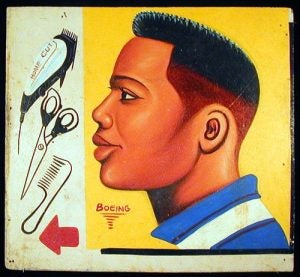
As earlier discussed, urban circumstances demanded signboards for advertising purposes, which various businesses commissioned. Barbershops and beauticians were frequent customers. Some signs might hang at the shop, while others stood at intersections to indicate the direction of the salon (Fig. 86). These began to catch the eye of Western travelers and researchers, who published articles about them. As they became better known, some museums and collectors bought them. This new secondary market began to expand, and prices outside Africa began to climb. From about $100 in 2007, they have increased considerably; in only a decade, some are now over $600, far from their cost to the original client.

Some artists who specialize in signs also produce paintings on spec, trusting that they may find a buyer. As their reputation increases, their expectations can be met. One Ghanaian artist, Kwame Akoto (aka “Almighty God”) has a roadside shop frequented by local customers looking for a sign, but also attracts international visitors who have encountered his work in books and exhibitions outside of Africa (Fig. 87). The more frequently work is published and publicly displayed, the more its value tends to increase.
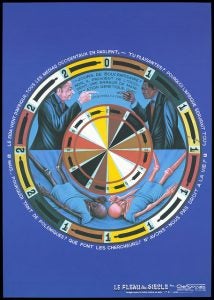
Some urban sign painters have made a complete transition to full-time non-commercial work. This is particularly frequent in the Democratic Republic of Congo, where the Congolese have long bought work to display in their homes–a fairly uncommon phenomenon elsewhere in West and Central Africa, where interior decoration is dominated by photographs, calendars, and foreign prints or paintings. The Kinshasa urban art scene has proliferated since the 1980s, due in part to two major museum exhibitions: the Paris show “Magiciens de la Terre” (1989) and New York’s “Africa Explores” (1991). These exhibitions and their catalogues launched the international careers of a number of African urban artists, including one of the continent’s best-known contemporary artists, Cheri Samba, who started life as a sign painter (Fig. 88). Despite his works’ subsequent presence in international collections and his travels throughout the world, Samba still sells to a local clientele in Kinshasa, but has separate pricing structures for foreign and domestic buyers.
Unusual Success without Formal Training
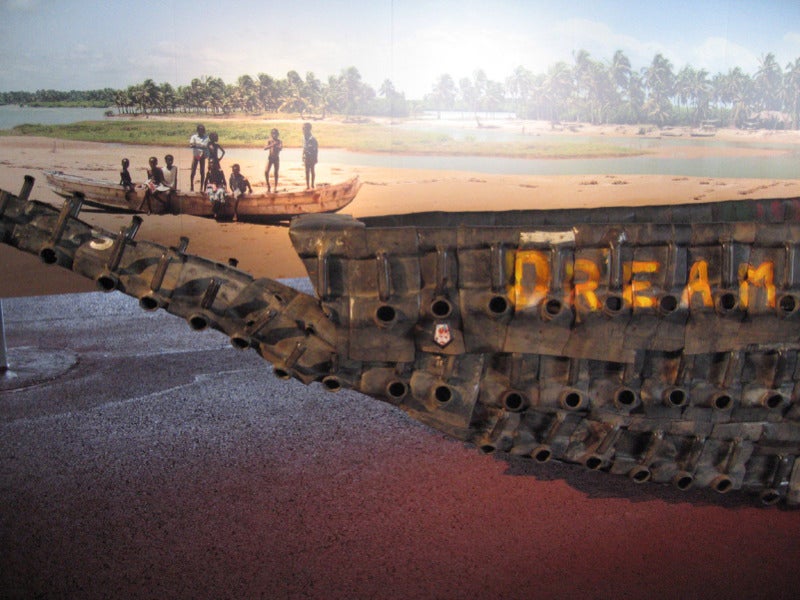
Romuald Hazoumé (Fig. 89), a Yoruba artist from Benin Republic, creates installations, large-scale projects that sometimes take up a whole gallery in a museum or have to be assembled on an outdoors site. In many cases, installations are unsuitable for private buyers because their spatial requirements would displace domestic activities; they are usually purchased by museums. A phenomenon created in the second half of the 20th century, installations are usually created by academically-trained artists from both the West and Asia. As an art form that is not usually commissioned and may not be bought, creating installations does not normally appeal to African artists who are Africa-based. Hazoumé is a notable exception. He was not formally trained as Fian artist aside from secondary school classes, either as an apprentice, through tertiary-level education, or through workshops. He began using plastic jerry cans (usually used to transport gasoline in West Africa) as a sculptural medium, noting their resemblance to masks and faces, and drew the attention of a foreign curator in the 1980s, with a London debut in the Saatchi Gallery’s 1992 “Out of Africa” exhibition. Major exhibitions followed, as did his 2007 prize-winning participation in documenta, one of the world’s foremost contemporary art venues, held every five years. Hazoumé remains in his hometown of Porto Novo, his art made almost exclusively for foreign consumption, despite themes with local significance.
Workshop-Trained Artist with Foreign and Local Clientele
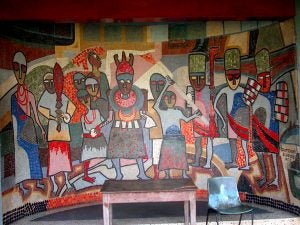
Artists whose visual education was limited to an arts workshop may have some local patrons, usually limited to a wealthy, educated client, or to hotels, banks and other businesses, and the government. Jimoh Buraimoh (Fig. 90), a Yoruba artist from Nigeria, was part of Ulli Beier’s Mbari Mbayo Club in the 1960s in Oshogbo, Nigeria. Through Beier’s publications and art world contacts in Germany and elsewhere, Buraimoh’s work drew the attention of the Nigerian government, who commissioned him to create a large outdoor mosaic at Lagos’s Murtala Mohammed Airport, as well as a more modestly-sized mosaic at the Benin City museum. He is best known for his bead paintings, many of which are in international private and museum collections. Though well-exhibited and published, his worldwide success is less than that of Hazoumé, probably because of timing and the latter’s use of recycled materials with a political message.
University and Polytechnic-Trained Artists with Local Clientele
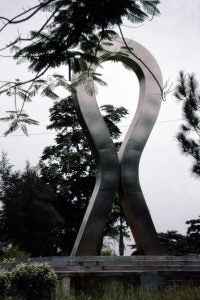
Most African artists with solely local training at the tertiary level find their sales options limited. They, too, might sell some artworks to wealthy, educated members of their own society, or to the government (Fig. 91) or the commercial sector, but they lack the contacts to reach a broader audience. Relatively few attract the attention of researchers and have their artworks published. When they do, it’s usually a matter of chance–an encounter with a traveler who’s a curator or art historian, an enquiry about one of their works seen on Facebook, a friendship with another artist who is represented abroad, or an opportunity to exhibit at a foreign embassy. Even without a broader audience, they may be able to make a living, but their livelihood is usually improved if they have a teaching position in a university or polytechnic.
Things are changing, since dedicated art galleries that represent local artists are growing in number. In previous decades, a shop in a hotel might sell a painting or two for an artist, but galleries that put on exhibitions that were reviewed and served as social venues were uncommon, with the exception of South Africa, whose art scene mimicked that of Europe.

The Locally-Trained Academic Exception
It has been even more unusual for a locally-trained African academic artist to break into the international art stage than it has been for vernacular artists. A notable exception is the sculptor El Anatsui, an Ewe artist from eastern Ghana who majored in art at KNUST, Kwame Nkrumah University of Science & Technology in Kumase. He left the country to take up a teaching position in eastern Nigeria in 1975, at the University of Nigeria, Nsukka, where he still works. While he was known for his ceramic and then his wooden sculptures made from recycled market trays (Fig. 92), it was as one of a group of academic artists who appeared in the (at the time) very occasional publications about contemporary art.
In 1998, however, at the age of 54, he began a new artistic direction. Collecting the metal tops of liquor bottles, he began to assemble them like the strip cloths of his homeland, creating impactful metal wall hangings that rapidly drew international attention and many sales to institutions and companies. He has been honored with a lifetime achievement award at the Venice Biennale (2015), which only Malian photographer Malick Sidibé had acquired (2007), as well as the Praemium Imperiale, the Japanese international art prize (2017) that no other African visual artist has received.
African Artists with Overseas Training

Not every African artist who schooled overseas goes on to achieve notable recognition, but their awareness of trends and opportunities can permit a more rapid ascent, particularly when their public narrative features Africa, making them stand out from the pack of other Western-trained artists. When they live overseas as well, their access to residencies and significant exhibitions increases their exposure and ability to make contacts with curators and collectors, and many have strategically maneuvered the art world to increasing success. This is a fairly recent phenomenon, however. Most art cognoscenti had little interest or exposure to contemporary African art until the late 1980s and early 1990s, when several key exhibitions in New York, London, and Paris began to attract attention. Fresh names and approaches (and lower prices) drew the interest of a new market that did not usually include collectors of traditional African art. Contemporary African art’s fashionability over the past two decades or so has led numerous exhibitions and publications, as well as to major world collections, including the 2017 establishment of the Zeitz Museum of Contemporary African Art in Capetown, South Africa.
Because of emigration, some African artists have now spent more time outside Africa than inside. One of the contemporary art world’s best-known artists is Yinka Shonibare, born in London to Yoruba parents, but a resident of Nigeria between the ages of 3 and 17, when he returned to London for his bachelors and MFA degrees in art. Like many foreign-trained African artists, his student exposure to Western art history and dialogues about the impact of colonialism and racial interaction are reflected in his works, many of which are installations. Shonibare has created photographs that insert his own presence into reworkings of Hogarth’s 18th-century “Rake’s Progress” series as well as Orson Welles’ “The Portrait of Dorian Gray” film, but his constructed mannequins dressed in European styles made from African wax prints are his best-known pieces (Fig. 93). The Queen knighted him with a CBE, and he has participated in both documenta and the Venice Biennale, as well as many one-man exhibitions, and has produced numerous public sculptures.

